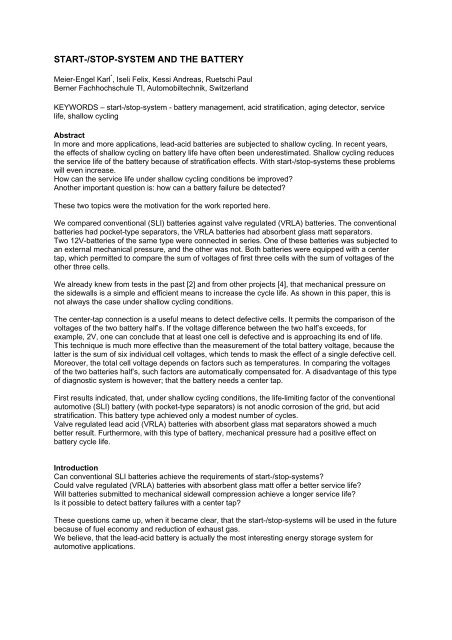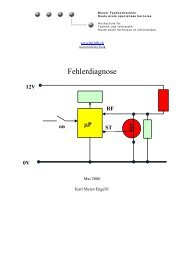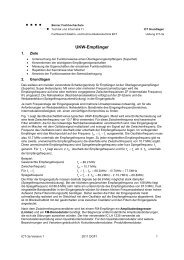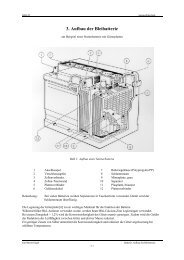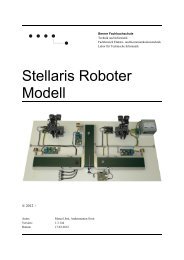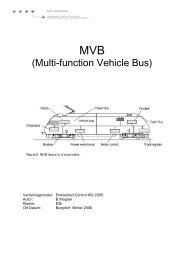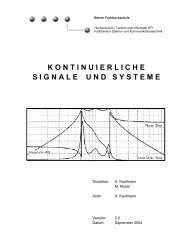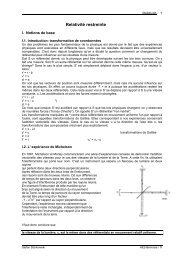start-/stop-system and the battery - Berner Fachhochschule
start-/stop-system and the battery - Berner Fachhochschule
start-/stop-system and the battery - Berner Fachhochschule
Create successful ePaper yourself
Turn your PDF publications into a flip-book with our unique Google optimized e-Paper software.
START-/STOP-SYSTEM AND THE BATTERY<br />
Meier-Engel Karl * , Iseli Felix, Kessi Andreas, Ruetschi Paul<br />
<strong>Berner</strong> <strong>Fachhochschule</strong> TI, Automobiltechnik, Switzerl<strong>and</strong><br />
KEYWORDS – <strong>start</strong>-/<strong>stop</strong>-<strong>system</strong> - <strong>battery</strong> management, acid stratification, aging detector, service<br />
life, shallow cycling<br />
Abstract<br />
In more <strong>and</strong> more applications, lead-acid batteries are subjected to shallow cycling. In recent years,<br />
<strong>the</strong> effects of shallow cycling on <strong>battery</strong> life have often been underestimated. Shallow cycling reduces<br />
<strong>the</strong> service life of <strong>the</strong> <strong>battery</strong> because of stratification effects. With <strong>start</strong>-/<strong>stop</strong>-<strong>system</strong>s <strong>the</strong>se problems<br />
will even increase.<br />
How can <strong>the</strong> service life under shallow cycling conditions be improved?<br />
Ano<strong>the</strong>r important question is: how can a <strong>battery</strong> failure be detected?<br />
These two topics were <strong>the</strong> motivation for <strong>the</strong> work reported here.<br />
We compared conventional (SLI) batteries against valve regulated (VRLA) batteries. The conventional<br />
batteries had pocket-type separators, <strong>the</strong> VRLA batteries had absorbent glass matt separators.<br />
Two 12V-batteries of <strong>the</strong> same type were connected in series. One of <strong>the</strong>se batteries was subjected to<br />
an external mechanical pressure, <strong>and</strong> <strong>the</strong> o<strong>the</strong>r was not. Both batteries were equipped with a center<br />
tap, which permitted to compare <strong>the</strong> sum of voltages of first three cells with <strong>the</strong> sum of voltages of <strong>the</strong><br />
o<strong>the</strong>r three cells.<br />
We already knew from tests in <strong>the</strong> past [2] <strong>and</strong> from o<strong>the</strong>r projects [4], that mechanical pressure on<br />
<strong>the</strong> sidewalls is a simple <strong>and</strong> efficient means to increase <strong>the</strong> cycle life. As shown in this paper, this is<br />
not always <strong>the</strong> case under shallow cycling conditions.<br />
The center-tap connection is a useful means to detect defective cells. It permits <strong>the</strong> comparison of <strong>the</strong><br />
voltages of <strong>the</strong> two <strong>battery</strong> half’s. If <strong>the</strong> voltage difference between <strong>the</strong> two half’s exceeds, for<br />
example, 2V, one can conclude that at least one cell is defective <strong>and</strong> is approaching its end of life.<br />
This technique is much more effective than <strong>the</strong> measurement of <strong>the</strong> total <strong>battery</strong> voltage, because <strong>the</strong><br />
latter is <strong>the</strong> sum of six individual cell voltages, which tends to mask <strong>the</strong> effect of a single defective cell.<br />
Moreover, <strong>the</strong> total cell voltage depends on factors such as temperatures. In comparing <strong>the</strong> voltages<br />
of <strong>the</strong> two batteries half’s, such factors are automatically compensated for. A disadvantage of this type<br />
of diagnostic <strong>system</strong> is however; that <strong>the</strong> <strong>battery</strong> needs a center tap.<br />
First results indicated, that, under shallow cycling conditions, <strong>the</strong> life-limiting factor of <strong>the</strong> conventional<br />
automotive (SLI) <strong>battery</strong> (with pocket-type separators) is not anodic corrosion of <strong>the</strong> grid, but acid<br />
stratification. This <strong>battery</strong> type achieved only a modest number of cycles.<br />
Valve regulated lead acid (VRLA) batteries with absorbent glass mat separators showed a much<br />
better result. Fur<strong>the</strong>rmore, with this type of <strong>battery</strong>, mechanical pressure had a positive effect on<br />
<strong>battery</strong> cycle life.<br />
Introduction<br />
Can conventional SLI batteries achieve <strong>the</strong> requirements of <strong>start</strong>-/<strong>stop</strong>-<strong>system</strong>s?<br />
Could valve regulated (VRLA) batteries with absorbent glass matt offer a better service life?<br />
Will batteries submitted to mechanical sidewall compression achieve a longer service life?<br />
Is it possible to detect <strong>battery</strong> failures with a center tap?<br />
These questions came up, when it became clear, that <strong>the</strong> <strong>start</strong>-/<strong>stop</strong>-<strong>system</strong>s will be used in <strong>the</strong> future<br />
because of fuel economy <strong>and</strong> reduction of exhaust gas.<br />
We believe, that <strong>the</strong> lead-acid <strong>battery</strong> is actually <strong>the</strong> most interesting energy storage <strong>system</strong> for<br />
automotive applications.
The advantages of lead-acid batteries are:<br />
low cost<br />
low internal resistance<br />
recyclability<br />
safety<br />
The aging mechanisms of lead acid batteries are (1):<br />
anodic corrosion of grids<br />
positive active mass degradation <strong>and</strong> loss of adherence to <strong>the</strong> grid<br />
irreversible formation of lead sulfate in <strong>the</strong> active mass<br />
short-circuits<br />
loss of water<br />
acid stratification<br />
In <strong>the</strong> past, most batteries failed by grid corrosion.<br />
Starting required only a very small fraction of <strong>the</strong> <strong>battery</strong> capacity. Most of <strong>the</strong> time <strong>the</strong> <strong>battery</strong><br />
remained almost completely charged. When <strong>the</strong> engine was running, <strong>the</strong> <strong>battery</strong> was charged by <strong>the</strong><br />
alternator, which resulted in permanent overcharge.<br />
When using <strong>start</strong>-/<strong>stop</strong>-<strong>system</strong>s, <strong>the</strong> batteries will be subjected to shallow cycling.<br />
This means, that during a <strong>stop</strong>, <strong>the</strong> <strong>battery</strong> must deliver <strong>the</strong> electric energy for <strong>the</strong> vehicle.<br />
In <strong>the</strong> present paper "shallow cycling" means cycling to a depth of discharge of about 5 to 20 %, at a<br />
discharge rate of about 1C.<br />
Starting an internal combustion engine means very high currents for a very short time. Therefore, a<br />
low internal resistance is a must.<br />
Unfortunately, <strong>the</strong> service life of <strong>the</strong> conventional SLI batteries, under shallow cycling conditions, is<br />
reduced. The reason is acid stratification.<br />
When batteries are subjected to a large number of cycles, one observes active mass degradation <strong>and</strong><br />
loss of adherence to <strong>the</strong> grid [3]. Mechanical compression on <strong>the</strong> sidewalls of <strong>the</strong> <strong>battery</strong>, will reduce<br />
<strong>the</strong>se processes.<br />
We already knew from tests in <strong>the</strong> past, that mechanical pressure is a simple <strong>and</strong> efficient means to<br />
increase <strong>the</strong> cycle life. As shown in this paper, this is not always <strong>the</strong> case under shallow cycling<br />
conditions.<br />
Failure detector<br />
Regarding <strong>start</strong>-/<strong>stop</strong> <strong>system</strong>s, it would be useful for <strong>the</strong> driver to know, if <strong>the</strong> <strong>battery</strong> is capable to<br />
provide <strong>the</strong> necessary energy for <strong>the</strong> next <strong>start</strong>ing operation. Modern automobiles should be equipped<br />
with an onboard diagnostic <strong>system</strong>, indicating any <strong>battery</strong> failure.<br />
From many <strong>battery</strong> tests we learned that normally one single cell is responsible for <strong>battery</strong> failure. One<br />
defect cell can cause problems with engine <strong>start</strong>.<br />
For a failure diagnosis one simple means is, to measure separately <strong>the</strong> voltages of <strong>the</strong> two <strong>battery</strong><br />
half’s. A difference of 2V ore more between this voltages indicates, that <strong>the</strong>re is a defect <strong>battery</strong> cell.<br />
We used a microprocessor to measure <strong>and</strong> compare <strong>the</strong>se voltages. This allowed to measure <strong>the</strong><br />
voltage difference also during very short discharge pulses.<br />
The idea described above was already patented in 1983 [5].<br />
Today, small <strong>and</strong> cheap microprocessors are available.<br />
However, measurements of half-<strong>battery</strong> voltages require a center-tap, which results in additional<br />
costs.<br />
For 24V or 36V electrical <strong>system</strong>s, <strong>the</strong> described failure detector can be easily installed at <strong>the</strong><br />
connection between <strong>the</strong> 12V blocs.
attery voltage<br />
half-<strong>battery</strong> voltage<br />
P<br />
information:<br />
“<strong>battery</strong> failure”<br />
Figure 1: Principle of <strong>the</strong> <strong>battery</strong> failure detector. A microprocessor is used for <strong>the</strong> measurement <strong>and</strong> it<br />
compares <strong>the</strong> half-<strong>battery</strong> voltages.<br />
Methods<br />
Test bench<br />
12Volt Battery<br />
with mechanical<br />
compression<br />
12 Volt Battery<br />
without<br />
mechanical<br />
compression<br />
Figure 2: principle of <strong>the</strong> test arrangement<br />
A test programme, according to figure 4 was carried out with two 12 V batteries connected in series.<br />
One <strong>battery</strong> was subjected to mechanical compression on <strong>the</strong> sidewalls, <strong>and</strong> <strong>the</strong> o<strong>the</strong>r was not.<br />
We tried different values of compression, between 10 <strong>and</strong> 100 kPa.<br />
We used ei<strong>the</strong>r conventional automotive (SLI) batteries (having pocket-type separators) or valve<br />
regulated lead acid (VRLA) batteries (having absorbent glass matt separators).<br />
Specifications of <strong>the</strong> batteries:<br />
Conventional (SLI) <strong>battery</strong>: nominal voltage: 12V<br />
capacity (C20):<br />
54Ah<br />
internal resistance:<br />
6mOhm<br />
elektrolyte:<br />
liquid<br />
dimensions (l/w/h):<br />
226/166/180mm<br />
weight:<br />
13,5kg
Valve regulated (VRLA) <strong>battery</strong>: nominal voltage 12V<br />
capacity:<br />
44Ah<br />
internal resistance:<br />
6mOhm<br />
electrolyte:<br />
in absorbent glass matt<br />
dimensions (l/w/h):<br />
196/164/171 mm<br />
weight:<br />
13,5 kg<br />
Figure 3: Device to maintain a sidewall mechanical compression, using disc springs. On <strong>the</strong> top of <strong>the</strong><br />
<strong>battery</strong> one recognises <strong>the</strong> failure detector.<br />
The test programme (figure 4), simulating conditions in a vehicle, consisted of 25 shallow cycles. We<br />
used a discharge current of 40A during 5min. (except <strong>the</strong> first discharge, which had a duration of<br />
10min.) <strong>and</strong> a charging current of 40A for 5min. This means a depth of discharge of about 10%.<br />
(Today, <strong>the</strong> average electric power for a vehicle electrical <strong>system</strong> will be more <strong>the</strong>n 500 W [6])<br />
The charge voltage was limited to 14,4V <strong>and</strong> <strong>the</strong> duration of charge was limited to 5min. Following this<br />
programme, a full charge <strong>and</strong> a capacity test was carried out, using a discharge current of 40A.<br />
This specification represents, in a simplified manner, <strong>the</strong> behaviour in a vehicle with a <strong>start</strong>-/<strong>stop</strong><strong>system</strong>.<br />
After every test cycle <strong>the</strong> <strong>battery</strong> capacity was determined by a full discharge.<br />
After failure of one <strong>battery</strong>, it was replace by a new one <strong>and</strong> <strong>the</strong> test was continued until <strong>the</strong> second<br />
<strong>battery</strong> would also fail.
test programme<br />
60<br />
40<br />
20<br />
current [A]<br />
0<br />
-20<br />
-40<br />
-60<br />
0 1 2 3 4 5 6 7 8 9 10 11 12<br />
time [h]<br />
Figure 4: The test programme <strong>start</strong>s with a full charge, followed by 25 partial discharges <strong>and</strong> 24 partial<br />
charges, <strong>and</strong> finally a full charge <strong>and</strong> a full discharge. The charge <strong>and</strong> discharge current was 40 A.<br />
Results <strong>and</strong> Discussion<br />
The conventional SLI batteries (with pocked-type separators) achieved 23 test programmes.<br />
Compression resulted in a slightly decreased capacity <strong>and</strong> slightly decreased cycle life. Post mortem<br />
analysis showed effects of acid stratification. The upper part of <strong>the</strong> positive plates showed a loss of <strong>the</strong><br />
adherence of <strong>the</strong> active mass, because this upper part had to work harder.<br />
The lower part of <strong>the</strong> plates showed signs of sulfation.<br />
A second set of conventional SLI <strong>battery</strong> was tested using a charge voltage of 15 V instead of 14.4 V.<br />
These batteries achieved 33 test programmes, whereby again <strong>the</strong> compressed <strong>battery</strong> failed before<br />
<strong>the</strong> uncompressed <strong>battery</strong>.<br />
Post mortem analysis showed strong signs of acid stratification.<br />
Regarding <strong>the</strong> valve regulated batteries, <strong>the</strong> <strong>battery</strong> without compression achieved 124 test<br />
programmes (see figure 5) <strong>and</strong> <strong>the</strong> compressed <strong>battery</strong> (100kPa) 157 test programmes.<br />
Using a compression of 20kPa we achieved 265 test programmes. Apparently, 100kPa is to much.<br />
VRLA batteries require a stronger <strong>battery</strong> case, because <strong>the</strong>y are mounted with absorbent glass matt<br />
separators under pressure.<br />
Using a compression device one could possibly utilize polypropylen as <strong>battery</strong> case material, which<br />
would be considerable cheaper <strong>the</strong>n ABS-cases.
35<br />
30<br />
25<br />
capacity [Ah]<br />
20<br />
15<br />
compressed <strong>battery</strong><br />
10<br />
5<br />
0<br />
0 20 40 60 80 100 120 140 160 180<br />
programme number<br />
Figure 5: This diagram shows <strong>the</strong> (poor) result with a conventional <strong>battery</strong> (with pocket-type<br />
separators) <strong>and</strong> a charge voltage of 15 V, at left, <strong>and</strong> <strong>the</strong> (much better) result of <strong>the</strong> valve regulated<br />
<strong>battery</strong> with glass mat separators.<br />
The compressed VRLA-<strong>battery</strong> achieved more programmes than <strong>the</strong> uncompressed <strong>battery</strong>.<br />
Half-<strong>battery</strong> voltages [V]<br />
9<br />
8<br />
7<br />
6<br />
5<br />
4<br />
3<br />
cells 1-3<br />
cells 4-6<br />
2<br />
2<br />
0 20 40 60 80 100 120 140<br />
5<br />
4<br />
3<br />
2<br />
1<br />
0<br />
1<br />
Difference of half-<strong>battery</strong> voltages [V]<br />
l<br />
time [h]<br />
Figure 6: Comparison of <strong>the</strong> half-<strong>battery</strong> voltages. The difference between <strong>the</strong> two half-cell voltages<br />
(lower curve) increases drastically at <strong>the</strong> end of life.
Conclusions<br />
Under shallow cycling conditions, conventional automotive (SLI) batteries achieved only a low number<br />
of cycles. Post mortem analysis showed signs of strong acid stratification. Acid stratification is <strong>the</strong> lifelimiting<br />
factor. Therefore, compression does not improve cycle life. The compressed batteries even<br />
failed before <strong>the</strong> uncompressed ones.<br />
On <strong>the</strong> o<strong>the</strong>r h<strong>and</strong>, valve-regulated (VRLA) batteries showed a much better cycle life. Post mortem<br />
analysis indicated no signs of acid stratification. But <strong>the</strong> active mass of <strong>the</strong> positive plates was<br />
relatively soft. Active mass degradation is a life-limiting factor. With compression, cycle life was<br />
improved.<br />
The aging detector proofed its effectiveness. It is a simple tool for failure detection.<br />
In <strong>start</strong>-/<strong>stop</strong>-<strong>system</strong>s it is preferred to use VRLA batteries.<br />
The use of a <strong>battery</strong>-fixing device, allowing sidewall compression, seems to be of interest.<br />
Acknowledgements<br />
The speaker expresses his thanks to:<br />
Paul Ruetschi, who has been a <strong>battery</strong> consultant for BFH-TI for many years.<br />
Reto Gasser, Felix Iseli, <strong>and</strong> Andreas Kessi, who have collaborated at <strong>the</strong> test laboratory.<br />
<strong>Berner</strong> <strong>Fachhochschule</strong>, University of applied sciences, for <strong>the</strong> use of <strong>the</strong> laboratories <strong>and</strong> <strong>the</strong> test<br />
benches.<br />
REFERENCES<br />
[1] Ruetschi Paul; “Aging Mechanisms <strong>and</strong> Service Live of Lead-Acid Batteries”, 2002, J. Power-<br />
Sources 127 (2004) 33-44<br />
[2] Meier-Engel Karl “OPAL Optimierung der Antriebsbatterie eines Elektrofahrzeuges”, 2004<br />
[3] Meier-Engel Karl, “ALBOCA Anhalten von Linienbussen und Speisung der Verbraucher mit<br />
BOOSTCAPS”, 2004<br />
[4] L. Torcheux, P. Gagnol, J.F. Sarrau: “InnovativeLead Acid Battery Development for electric &<br />
Hybrid Vehicle applications”, EVS-22 Yokohama, 2006<br />
[5] Kahlen Hans: “Control Device for Battery” EEP 0080164<br />
[6] BOSCH; “Autoelektrik Autoelektronik” ISBN 3-528-23872-0


